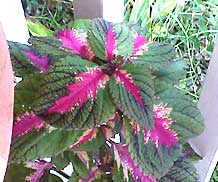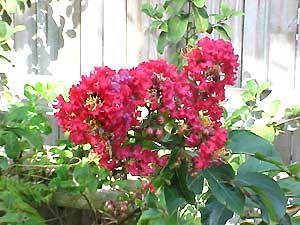Sunday, August 20, 2006
Annuals are beautiful too
I've been chewing on this one for quite some time now and I finally reached the point where I had to put in my two cents. There was a very short article in the paper about two months ago discussing the benefits of perennials vs annuals. The upshot of the article was that designer gardeners didn't lower themselves to add annuals to their gardens, and the piece literally ended with the following quote, "Friends don't let friends plant annuals."
My first thought was, how dare some group of snots come along and try to take the beauty and zen out of such a personal experience. Who are "they" to tell others that not only are annuals passe, but you are pretty much a goober if you plant them. Then I dismissed the whole thing for what it really was - a bag of cow manure - and promptly went out to commune with nature...until today.
 Why today you ask? Well, it's August 20 and, as my dad used to say, hotter than the hinges of Hades. I wanted to garden but the humidity levels had me drenched before I even pulled out my gloves and trowel. Then I remembered I had recently purchased some coleus, a sweet potato vine, and a large terra cotta pot. So I got busy planting in the shade of my front porch, still sweaty but a lot more bearable. The plants are beautiful and guess what else? Dare I say it? They are annuals. These plants are easy to see from the kitchen, easy to care for, and will last for quite some time.
Why today you ask? Well, it's August 20 and, as my dad used to say, hotter than the hinges of Hades. I wanted to garden but the humidity levels had me drenched before I even pulled out my gloves and trowel. Then I remembered I had recently purchased some coleus, a sweet potato vine, and a large terra cotta pot. So I got busy planting in the shade of my front porch, still sweaty but a lot more bearable. The plants are beautiful and guess what else? Dare I say it? They are annuals. These plants are easy to see from the kitchen, easy to care for, and will last for quite some time.  In fact, I have some coleus that over-wintered and are on their second year on the front porch. Imagine that. So the next time someone tries to talk you down from putting annuals in your landscape, just turn to them with a smile and say, "I love annuals and I'm not afraid to plant them." Happy Gardening from one goober to another.
In fact, I have some coleus that over-wintered and are on their second year on the front porch. Imagine that. So the next time someone tries to talk you down from putting annuals in your landscape, just turn to them with a smile and say, "I love annuals and I'm not afraid to plant them." Happy Gardening from one goober to another.
My first thought was, how dare some group of snots come along and try to take the beauty and zen out of such a personal experience. Who are "they" to tell others that not only are annuals passe, but you are pretty much a goober if you plant them. Then I dismissed the whole thing for what it really was - a bag of cow manure - and promptly went out to commune with nature...until today.
 Why today you ask? Well, it's August 20 and, as my dad used to say, hotter than the hinges of Hades. I wanted to garden but the humidity levels had me drenched before I even pulled out my gloves and trowel. Then I remembered I had recently purchased some coleus, a sweet potato vine, and a large terra cotta pot. So I got busy planting in the shade of my front porch, still sweaty but a lot more bearable. The plants are beautiful and guess what else? Dare I say it? They are annuals. These plants are easy to see from the kitchen, easy to care for, and will last for quite some time.
Why today you ask? Well, it's August 20 and, as my dad used to say, hotter than the hinges of Hades. I wanted to garden but the humidity levels had me drenched before I even pulled out my gloves and trowel. Then I remembered I had recently purchased some coleus, a sweet potato vine, and a large terra cotta pot. So I got busy planting in the shade of my front porch, still sweaty but a lot more bearable. The plants are beautiful and guess what else? Dare I say it? They are annuals. These plants are easy to see from the kitchen, easy to care for, and will last for quite some time.  In fact, I have some coleus that over-wintered and are on their second year on the front porch. Imagine that. So the next time someone tries to talk you down from putting annuals in your landscape, just turn to them with a smile and say, "I love annuals and I'm not afraid to plant them." Happy Gardening from one goober to another.
In fact, I have some coleus that over-wintered and are on their second year on the front porch. Imagine that. So the next time someone tries to talk you down from putting annuals in your landscape, just turn to them with a smile and say, "I love annuals and I'm not afraid to plant them." Happy Gardening from one goober to another.Sunday, August 06, 2006
Crape myrtle
 I love crape myrtle. It makes such a gorgeous tree with it's beautiful flowers and almost weeping shape. Lagerstroemia indica originated in China and was named after Magnus von Lagerstroem (somehow I don't see a crape or a myrtle in that name, but maybe Magnus's nickname was Myrtle). Crapes can be trained into shrubs or, if allowed to grow, will become small trees. They flower in summer in colors range from pink to red to lavender and do best in sun with regular watering.
I love crape myrtle. It makes such a gorgeous tree with it's beautiful flowers and almost weeping shape. Lagerstroemia indica originated in China and was named after Magnus von Lagerstroem (somehow I don't see a crape or a myrtle in that name, but maybe Magnus's nickname was Myrtle). Crapes can be trained into shrubs or, if allowed to grow, will become small trees. They flower in summer in colors range from pink to red to lavender and do best in sun with regular watering.One of the things that people generally don't notice is the beauty of its trunk particularly as it gets up to about 8-10 feet tall. The trunk is mottled in a variety of grays and reminds me somewhat of a birch tree. Prune as spring approaches trimming up the older branches and either thinning to be more tree like or just removing weak limbs that won't flower. With a little care you will be rewarded with a lovely addition to the landscape. Happy Gardening.

This work is licensed under a Creative Commons License.
Thanks to Andrew Stenning who contributed the photograph for our masthead
